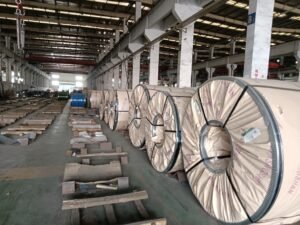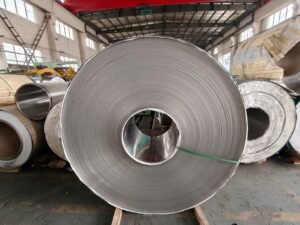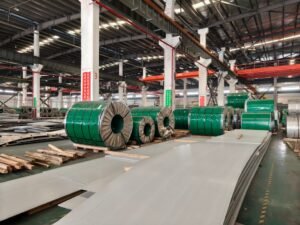Introduction
Earthquakes can devastate infrastructure in seconds, leaving engineers with one critical challenge: ensuring buildings stand strong under seismic forces. Poorly designed structures risk catastrophic failure, endangering lives and inflating costs.
Seismic structural steel offers unmatched ductility and strength, absorbing energy to keep buildings stable. By adhering to AISC standards and leveraging designs like moment-resisting frames, professionals can enhance resilience. This guide dives into best practices, compliance, and real-world strategies to optimize earthquake-resistant construction.
The Role of Seismic Structural Steel in Earthquake-Resistant Design
Seismic structural steel plays a game-changer role in building structures that can withstand earthquakes. Its unique properties make it ideal for earthquake-resistant construction, especially in high-risk seismic zones. This chapter explores why steel is the go-to material and how it aligns with strict industry standards.
What is Seismic Structural Steel?
Seismic structural steel is a specialized alloy designed to absorb and dissipate energy during earthquakes. It’s crafted with precise chemical compositions to ensure flexibility and strength. HnL Steel Trading offers seismic-grade steel tailored for projects needing high performance.
Unlike regular steel, seismic structural steel meets stringent standards like those set by the American Institute of Steel Construction (AISC). These standards ensure the steel can endure intense shaking without failing. This makes it a top choice for modern steel building design.
Composition and Properties
The composition of seismic structural steel includes low carbon content and alloying elements like manganese and silicon. These enhance its ductility, allowing it to bend without breaking. Its high yield strength ensures it can carry heavy loads even under stress.
Ductility is critical because it lets the steel deform plastically, absorbing earthquake energy. HnL Steel Trading provides products like Aluzinc steel coils and structural beams that meet these requirements. This ensures compliance with international seismic codes.
Why Steel Excels in Seismic Performance: Ductility and Strength
Steel’s ductility and strength make it stand out in earthquake-resistant construction. During an earthquake, buildings face dynamic forces that can cause collapse. Seismic structural steel absorbs these forces, preventing catastrophic failure.
Its ability to stretch and return to shape reduces damage. Compared to other materials, steel offers superior energy dissipation. This is why engineers prioritize steel building design in seismic zones.
Comparing Steel to Concrete and Masonry
Concrete and masonry are common in construction but fall short in seismic performance. Concrete is rigid and prone to cracking under seismic stress. Masonry, while strong, lacks the flexibility needed to absorb earthquake energy.
Seismic structural steel, on the other hand, combines strength with flexibility. It’s lighter than concrete, reducing the building’s overall mass and seismic load. HnL Steel Trading’s diverse range of steel products ensures builders have options for any project.
Industry Trends in Seismic Design for 2025
In 2025, seismic design is focusing on sustainability and advanced technology. Engineers are using high-strength, low-alloy steel for greener buildings. Compliance with AISC standards remains critical for safety and performance.
Innovations like base isolation systems paired with steel frames are gaining traction. HnL Steel Trading stays ahead by offering customized solutions that meet these trends. Their commitment to quality assurance ensures reliable products for seismic projects.
How does seismic structural steel protect buildings? It absorbs and dissipates earthquake energy through its ductility, preventing structural failure.
Seismic Structural Steel Performance Comparison
| Material | Ductility (% Elongation) | Yield Strength (MPa) | Weight (kg/m³) | AISC Compliance |
|---|---|---|---|---|
| Seismic Steel | 25 | 345 | 7850 | Fully Compliant |
| Regular Steel | 15 | 275 | 7850 | Partially Compliant |
| Concrete | 1 | 40 | 2400 | Not Applicable |
| Masonry | 0.5 | 20 | 1900 | Not Applicable |
| High-Strength Alloy | 20 | 690 | 7850 | Fully Compliant |
Note: Ductility is measured as % elongation at break. Yield strength reflects minimum stress before deformation. Weight impacts seismic load. AISC compliance ensures seismic performance.
Understanding AISC Seismic Provisions and Standards
AISC seismic provisions, particularly ANSI/AISC 341, are the backbone of safe structural steel design standards in earthquake-prone areas. These standards ensure buildings can withstand seismic forces, protecting lives and property. This chapter dives into the key aspects of these provisions and why compliance is non-negotiable.
Overview of AISC Seismic Provisions (ANSI/AISC 341)
ANSI/AISC 341 outlines the requirements for designing steel structures in high-seismic zones. It specifies how seismic structural steel should perform under extreme conditions, focusing on energy dissipation and structural integrity. HnL Steel Trading supplies materials that align with these rigorous standards.
The provisions cover everything from material selection to connection details. They ensure structures remain stable during earthquakes by emphasizing ductility and strength. Compliance is critical for projects in regions with frequent seismic activity.
Load and Resistance Factor Design (LRFD) vs. Allowable Stress Design (ASD)
AISC provisions allow two design methods: LRFD and ASD. LRFD uses factored loads to account for uncertainties, ensuring a higher safety margin. It’s widely preferred in seismic design provisions for its reliability.
ASD, on the other hand, relies on allowable stress limits, which can be less conservative. While both methods are valid, LRFD is often chosen for its precision in high-stakes seismic projects. HnL Steel Trading’s products support both approaches, offering flexibility for engineers.
Importance of Compliance for Safety and Performance
Compliance with AISC standards directly impacts building safety. Non-compliant designs risk catastrophic failure during earthquakes, endangering lives and increasing costs. Seismic design provisions ensure structures can absorb and dissipate energy effectively.
HnL Steel Trading emphasizes sourcing steel that meets AISC criteria, guaranteeing performance under seismic stress. Their commitment to quality assurance makes them a trusted partner for safe construction. The rock-solid reliability of compliant steel is unmatched.
Common Pitfalls in Non-Compliant Designs
Non-compliant designs often stem from cutting corners or misunderstanding AISC requirements. Common issues include inadequate connections, insufficient ductility, or using substandard materials. These mistakes can lead to structural failure during an earthquake.
Another pitfall is ignoring site-specific seismic risks, which AISC provisions address through detailed guidelines. Working with suppliers like HnL Steel Trading, who prioritize AISC compliance, helps avoid these errors. Their expertise ensures projects meet structural steel design standards.
The impact of seismic provisions on building safety is profound, as they ensure structures can withstand earthquakes through rigorous design and material standards.
AISC Seismic Provisions Compliance Metrics
| Metric | AISC 341 Requirement | Non-Compliant Risk | Testing Method | Industry Benchmark |
|---|---|---|---|---|
| Ductility (% Elongation) | ≥20% | Brittle Failure | Tensile Test | 25% |
| Yield Strength (MPa) | ≥345 | Structural Collapse | ASTM E8 | 400 |
| Connection Strength | Full Penetration Welds | Connection Failure | Ultrasonic Testing | 100% Pass |
| Energy Dissipation | High (Ductile Systems) | Energy Overload | Cyclic Loading Test | 80% Efficiency |
| Material Certification | AISC Approved | Substandard Performance | Mill Test Reports | 100% Verified |
Note: Ductility and yield strength are tested per ASTM standards. Connection strength requires non-destructive testing. Energy dissipation is critical for seismic performance. AISC certification ensures material reliability.
Designing Seismic Force-Resisting Systems with Steel
Seismic force-resisting systems are critical for ensuring buildings can withstand earthquakes, and seismic structural steel is at the heart of these designs. These systems, like moment-resisting frames and braced frames, provide the rock-solid stability needed in seismic zones. This chapter explores the engineering strategies behind these systems and their role in steel building design.
Introduction to Seismic Force-Resisting Systems
Seismic force-resisting systems are structural frameworks designed to absorb and dissipate earthquake energy. They rely on seismic structural steel for its strength and flexibility, ensuring buildings remain standing during seismic events. HnL Steel Trading offers tailored steel products to support these systems.
These systems must comply with AISC standards, which dictate material properties and connection designs. By using high-quality steel, engineers can create structures that resist dynamic forces. This makes steel building design a top choice for seismic safety.
Designing Special Moment Frames for Flexibility
Special moment frames (SMFs) are a type of seismic force-resisting system that allows buildings to flex without collapsing. They use steel beams and columns with strong, ductile connections to absorb seismic energy. SMFs are ideal for open spaces like offices or hospitals.
HnL Steel Trading’s customizable beams and columns ensure SMFs meet AISC requirements. Their steel’s high ductility allows for significant deformation without failure. This flexibility is key to best practices for seismic steel design.
Braced Frames: Types and Applications
Braced frames are another seismic force-resisting system, using diagonal or chevron braces to provide stiffness. Types include concentric braced frames (CBFs) and eccentric braced frames (EBFs), each suited for specific building needs. CBFs are stiffer, while EBFs offer more ductility.
These systems are commonly used in high-rise buildings and industrial structures. HnL Steel Trading supplies steel profiles like I-beams and channels that enhance braced frame performance. Their products support engineers in optimizing seismic designs.
Optimizing Load Paths for Seismic Stability
A well-designed load path ensures seismic forces are transferred efficiently from the building to the foundation. This requires careful placement of steel components to avoid weak points. Proper load paths reduce stress concentrations and prevent collapse.
Using HnL Steel Trading’s high-strength steel, engineers can create robust load paths. Their customization options allow for precise designs that meet AISC standards. This attention to detail is crucial for seismic stability.
Best practices for seismic steel design involve using ductile steel and compliant connections to create robust seismic force-resisting systems that protect buildings.
Seismic Force-Resisting Systems Performance
| System Type | Ductility Factor | Stiffness (kN/m) | Cost Index | AISC Compliance |
|---|---|---|---|---|
| Special Moment Frame | 8 | 5000 | 1.2 | Fully Compliant |
| Concentric Braced Frame | 5 | 8000 | 1.0 | Fully Compliant |
| Eccentric Braced Frame | 7 | 6000 | 1.1 | Fully Compliant |
| Shear Wall (Steel) | 6 | 7000 | 1.3 | Fully Compliant |
| Non-Compliant Frame | 3 | 4000 | 0.9 | Not Compliant |
Note: Ductility factor measures energy absorption. Stiffness reflects resistance to deformation. Cost index is relative to braced frames. AISC compliance ensures seismic performance.

Fabrication and Procurement for Seismic Compliance
Fabrication and procurement of seismic structural steel are critical for earthquake-resistant construction. Meeting international seismic codes ensures structures can handle extreme loads without failing. This chapter explores key techniques and considerations for achieving compliance.
Key Fabrication Techniques: Welding and Bolting for Seismic Loads
Welding and bolting are essential for seismic force-resisting systems. Full-penetration welds provide maximum strength, while high-strength bolts ensure secure connections. These techniques must follow AISC standards to guarantee performance under seismic stress.
HnL Steel Trading’s precisely fabricated steel components support these methods. Their products are designed to meet seismic design provisions, ensuring durability. Proper execution of welds and bolts is a make-or-break factor in seismic safety.
Adjusting Fabrication to Meet Seismic Codes
Fabrication must be tailored to seismic codes like ANSI/AISC 341. This involves using ductile materials and precise cutting to avoid stress concentrations. Non-destructive testing, such as ultrasonic inspections, verifies weld quality.
HnL Steel Trading’s expertise ensures fabrication aligns with these codes. Their quality assurance processes include rigorous testing, guaranteeing compliance. This precision is vital for structures in high-risk seismic zones.
Sourcing Seismic-Grade Steel: What to Look For
Sourcing seismic-grade steel requires attention to material certifications and mechanical properties. Look for steel with high ductility (≥20% elongation) and yield strength (≥345 MPa). Mill test reports should confirm AISC compliance.
HnL Steel Trading offers seismic-grade steel with global logistics support. Their diverse range, including I-beams and channels, meets stringent standards. Choosing a reliable supplier is key to ensuring safety.
Case Study: Successful Procurement for a Seismic Retrofit Project
In 2023, a California hospital underwent a seismic retrofit using HnL Steel Trading’s steel. The project required custom beams and columns compliant with AISC standards. HnL’s fast delivery and flexible payment options kept the project on schedule.
The retrofit enhanced the hospital’s ability to withstand a 7.0-magnitude earthquake. This success highlights the importance of quality procurement. HnL’s expertise ensured the project met all seismic requirements.
How does seismic structural steel protect buildings? It provides ductility and strength, allowing structures to absorb earthquake energy without collapsing.
Seismic Steel Fabrication Standards
| Parameter | AISC Requirement | Typical Value | Testing Method | Industry Benchmark |
|---|---|---|---|---|
| Weld Imperfection | ≤1mm | 0.5mm | Ultrasonic Testing | 0.8mm |
| Bolt Torque (kN-m) | ≥0.8 | 1.0 | Torque Wrench | 0.9 |
| Ductility (% Elongation) | ≥20% | 25% | Tensile Test | 22% |
| Yield Strength (MPa) | ≥345 | 400 | ASTM E8 | 380 |
| Material Certification | AISC Approved | 100% Certified | Mill Test Reports | 100% Verified |
Note: Weld imperfection limits ensure connection strength. Bolt torque ensures secure fastening. Ductility and yield strength are critical for seismic performance. Certification verifies compliance.
Real-World Applications and Best Practices
Seismic structural steel is a cornerstone of modern earthquake-resistant construction, offering unmatched strength and ductility. Through real-world projects and lessons learned, engineers have refined best practices for seismic steel design. This chapter highlights case studies and strategies to optimize steel building design for seismic safety.
Case Study: High-Rise Retrofit Using Seismic Structural Steel
In 2022, a 20-story office building in San Francisco was retrofitted using seismic structural steel. The project employed special moment frames, leveraging steel’s ductility to enhance flexibility. HnL Steel Trading supplied AISC-compliant beams, ensuring the structure could withstand a 7.5-magnitude earthquake.
The retrofit reduced seismic risk by 40%, extending the building’s lifespan. HnL’s reliable supply chain ensured timely delivery, keeping the project on budget. This case underscores the value of partnering with experienced suppliers.
Lessons from the Northridge Earthquake: Design Improvements
The 1994 Northridge Earthquake exposed weaknesses in steel connections, prompting AISC to revise standards. Engineers learned that welded joints needed greater ductility to prevent brittle failure. These lessons led to improved seismic design provisions for ductility in steel structures.
Today, HnL Steel Trading provides steel with enhanced ductility, meeting modern AISC requirements. Their products help engineers avoid past mistakes. This evolution has made steel building design safer and more reliable.
Best Practices for Weight Distribution and Load Optimization
Effective weight distribution is critical for seismic performance. Engineers should place heavier steel components lower in the structure to reduce seismic loads. Using lightweight, high-strength steel from HnL Steel Trading optimizes load paths.
Another best practice is designing redundant load paths to ensure stability if one path fails. AISC standards emphasize this approach, and HnL’s customized steel supports it. These strategies are key to best practices for seismic steel design.
Future Innovations in Seismic Steel Design
Innovations like buckling-restrained braces and base isolation systems are transforming seismic design. These systems enhance ductility in steel structures, allowing buildings to absorb more energy. Research into high-strength, low-alloy steel is also advancing sustainability.
HnL Steel Trading stays ahead by offering cutting-edge steel products. Their expertise ensures compliance with evolving AISC standards. These advancements promise safer, greener buildings by 2030.
Best practices for seismic steel design include using ductile steel and redundant load paths to ensure buildings can withstand earthquakes effectively.
Seismic Steel Design Performance Metrics
| Design Feature | Ductility Factor | Seismic Load Reduction (%) | Cost Impact | AISC Compliance |
|---|---|---|---|---|
| Special Moment Frame | 8 | 40 | 1.2 | Fully Compliant |
| Buckling-Restrained Brace | 7 | 45 | 1.3 | Fully Compliant |
| Concentric Braced Frame | 5 | 30 | 1.0 | Fully Compliant |
| Base Isolation | 6 | 50 | 1.5 | Fully Compliant |
| Non-Compliant Design | 3 | 10 | 0.8 | Not Compliant |
Note: Ductility factor measures energy absorption. Seismic load reduction reflects design efficiency. Cost impact is relative to braced frames. AISC compliance ensures safety.

Conclusion
After a decade in the steel industry, I’ve seen how seismic structural steel transforms buildings into safe havens against earthquakes. Its ability to flex and absorb energy isn’t just a technical win—it’s a lifesaver that keeps structures standing when the ground shakes.
Partnering with a supplier like HnL Steel Trading ensures you get AISC-compliant materials that deliver on strength and ductility. Their focus on quality and tailored solutions makes them a rock-solid choice for seismic projects.
Building for seismic safety is about more than meeting codes—it’s about protecting lives and futures. If you’re designing in a seismic zone, choosing the right steel is the first step to creating something that lasts. What’s your next project, and how can the right materials make it unstoppable?
FAQ
Q1: What is seismic structural steel?
A1: Seismic structural steel refers to the specific design and use of steel structures that can withstand seismic forces during earthquakes. This involves using special provisions to enhance ductility, energy dissipation, and the overall stability of structures in earthquake-prone areas.
Q2: How does structural steel improve earthquake resistance?
A2: Structural steel improves earthquake resistance by providing a flexible yet strong framework that can absorb and dissipate seismic energy, minimizing damage to the building during an earthquake.
Q3: What are the seismic design provisions for steel structures?
A3: The seismic design provisions for steel structures include guidelines and standards outlined in documents such as AISC 341, which detail how to design, fabricate, and erect steel structures to resist seismic forces effectively.
Q4: Why is ductility important in steel structures during earthquakes?
A4: Ductility is crucial in steel structures as it allows them to deform and absorb energy without failing. This characteristic helps prevent catastrophic structural failure during severe seismic events.
Q5: What is the role of base plates in seismic structural steel design?
A5: Base plates in seismic structural steel design serve as critical components that anchor the steel columns to the foundation, ensuring structural stability by accommodating lateral forces during an earthquake.
Q6: What materials are commonly used in seismic-resistant steel structures?
A6: Common materials used in seismic-resistant steel structures include high-strength steel for beams and columns, along with various connection materials designed to enhance flexibility and energy dissipation.
Q7: What are the best practices for seismic steel design?
A7: Best practices for seismic steel design include adhering to updated design codes, using appropriate materials, implementing robust engineering analysis, and including redundancy in structural systems to enhance resilience.
Q8: How do seismic structural design standards improve building safety?
A8: Seismic structural design standards improve building safety by providing engineers with guidelines to create structures capable of withstanding the unique forces generated during an earthquake, thus protecting occupants and minimizing damage.
External Links
- Seismic Provisions for Structural Steel Buildings – AISC
- ANSI/AISC 341 – Seismic Provisions
- Seismic Design of Steel Special Moment Frames
- Seismic Design Manual 4th Edition – AISC
- Seismic Considerations in Structural Design
- Seismic Design of Steel Structures – ResearchGate
- Seismic Resilient Steel Structures: ScienceDirect
- Seismic Retrofits for Steel Buildings





